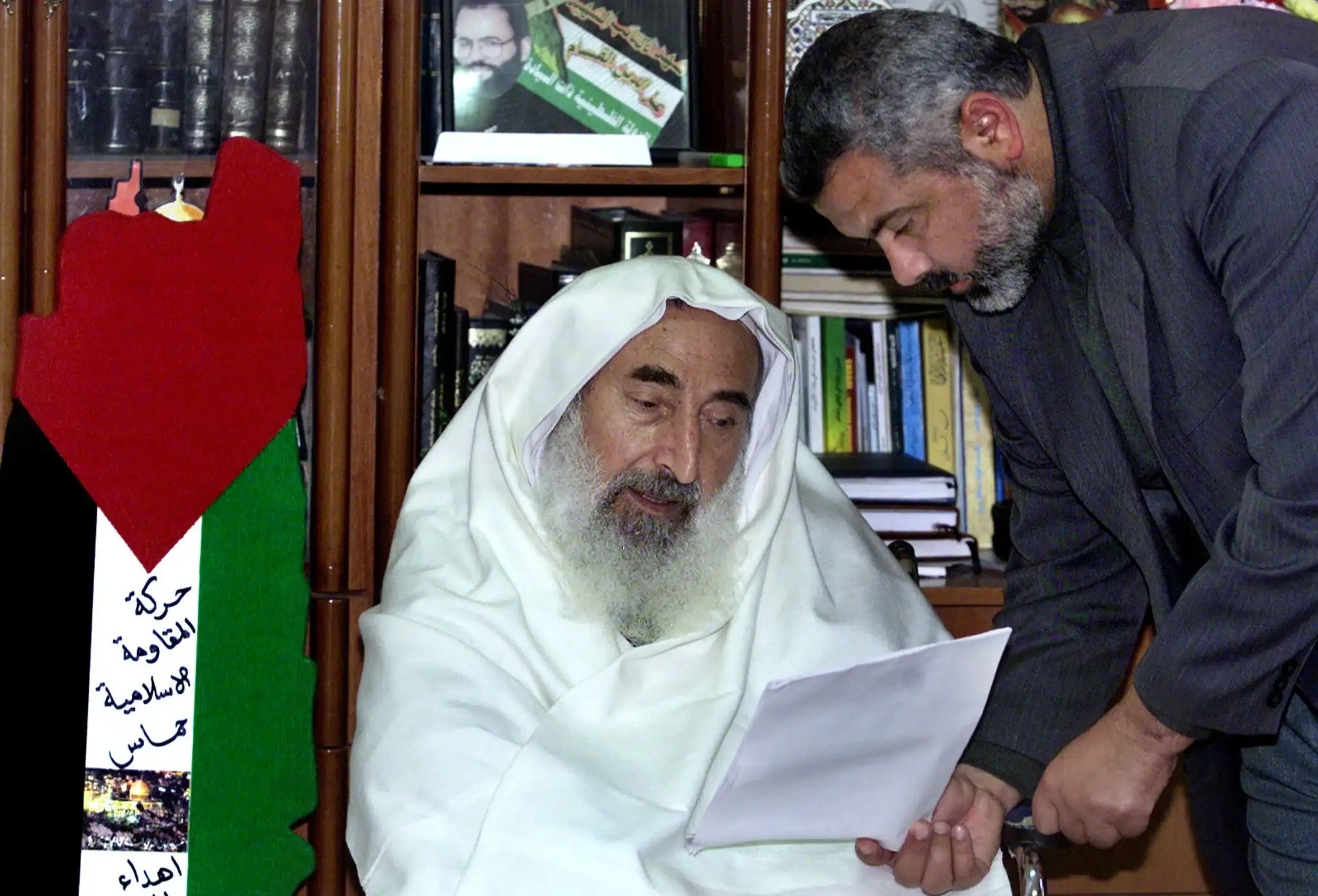


Anadolu Agency
The announcement of Hamas leader Ismail Haniyeh's assassination in Tehran on Wednesday has once again brought to the forefront the extensive campaign of targeted killings carried out by Israel against prominent political and military figures within the movement since its founding in 1987.
Among the most prominent Hamas leaders assassinated by Israel are the movement's founder and leader, Ahmed Yassin, his successor in leading Hamas within the Palestinian territories, Abdel Aziz Rantisi, and Salah Shehada, the de facto founder of the movement's military wing, the Izz ad-Din al-Qassam Brigades.
Here are 10 of the most notable Hamas leaders targeted by Israel's assassination program over the past three decades:
1. Ismail Haniyeh
One of the most prominent Palestinian political leaders and a symbol of Hamas, Haniyeh served as Prime Minister of the Palestinian government between 2006 and 2007. Hamas announced his assassination on Wednesday in an "Israeli airstrike" targeting his residence in Tehran.
In a statement, Hamas said the movement "mourns the Palestinian people, the Arab and Islamic nation, and all the free people of the world for the loss of the brother, the leader, the martyr, the mujahid Ismail Haniyeh, the head of the movement, who was killed in a treacherous attack by the Zionist entity that targeted his residence in Tehran, after participating in the inauguration ceremony of the new Iranian president."
As of 7:15 PM GMT, there has been no official Israeli statement on the matter.
Haniyeh's last public appearance in Tehran was during the inauguration ceremony of Iranian President Ebrahim Raisi on Tuesday evening.
In 2021, Haniyeh was re-elected as head of Hamas' political bureau for a second consecutive term, ending in 2025.
Haniyeh began his political activity within the "Islamic Bloc," the student wing of the Muslim Brotherhood, from which Hamas later emerged. He was arrested multiple times by the Israeli army.
2. Saleh al-Arouri
Born in 1966 in the town of Al-Aroura near Ramallah in the occupied West Bank, al-Arouri is considered the second-in-command in Hamas. He played a role in establishing the Izz ad-Din al-Qassam Brigades and spent 18 years in Israeli prisons.
He led the Islamic student movement at Hebron University from 1985 until his arrest in 1992 and joined Hamas after its founding in late 1987.
In 2014, Tel Aviv accused him of planning the kidnapping and murder of three Israelis in the West Bank.
4- Jamila Al-Shanti
Her name came to prominence on November 3, 2006, when a women's march led by her succeeded in breaking the siege imposed by the Israeli army on a mosque in the town of Beit Hanoun, north of the Gaza Strip, which included dozens of resistance fighters.
In 2006, she was elected as a member of the Legislative Council (parliament) for the "Reform and Change" bloc, representing Hamas.
In 2013, Al-Shanti was appointed Minister of Women in the "Hamas government" that was running the Gaza Strip.
She became a member of the Hamas Political Bureau in 2021 as the first woman in the office.
Al-Shanti was born in the Jabalia Palestinian refugee camp, north of the Gaza Strip, in 1957.
In 1980, she obtained a bachelor's degree in English from Ain Shams University in Egypt, then moved to work in Saudi Arabia as a teacher for 10 years.
Al-Shanti returned to the Gaza Strip in 1990 to join the organizational work in Hamas.
She was assassinated by Israel in a raid that targeted her home in Gaza City on October 18, 2023.
5- Raed Al-Attar
Al-Attar was a member of the military council of the Al-Qassam Brigades and one of its founders. He was leading the "Rafah Brigade" when he was killed after Israel put him on the list of most wanted persons for assassination.
The Israeli internal security service "Shabak" described him as one of the most powerful leaders of the Al-Qassam Brigades, and responsible for the entire Rafah area militarily, and accused him of building Hamas's underground tunnel system.
Al-Attar planned the attack launched by the Al-Qassam Brigades in the Kerem Shalom area in 2006, in which two Israeli soldiers were killed and the soldier Gilad Shalit was captured.
Israel also held him responsible for killing the officer in its army, Hadar Goldin, during its war on Gaza in 2014 and keeping his body.
Al-Attar joined the ranks of the Qassam Brigades in 1994, where he participated in the attack on an Israeli military site on the border between Egypt and Israel, in which an Israeli officer was killed.
He was assassinated by Israel in an air strike that targeted a house in the city of Rafah in the southern Gaza Strip on August 21, 2014.
6- Ahmed al-Jaabari
Al-Jaabari was born in the Gaza Strip in 1960, and at the beginning of his political activity, he joined the Fatah movement.
However, while in prison, he met the founder of Hamas, Ahmed Yassin, and his relationship with the leaders of the movement was strengthened, which he joined after his release from prison in 1995.
In 2000, he became the third of three in the military council of the Qassam Brigades, along with Muhammad al-Deif and Salah Shehadeh.
After Al-Daif was seriously injured in an assassination attempt in 2003, Al-Jaabari became the de facto leader of the Al-Qassam Brigades, as Al-Daif's deputy and he began to bear the title of "Hamas Chief of Staff" and "the tough number", according to the description of the Israeli security and military leadership.
He played an important role in organizing and coordinating military activities against Israel, and supervised the exchange of Palestinian prisoners in exchange for the soldier Shalit in 2011.
In November 2012, Israel assassinated Al-Jaabari in an air strike in Gaza City.
7- Nizar Rayyan
One of the senior political and military leaders in Hamas.
He participated in military work with the Al-Qassam Brigades, and served as a member of the Hamas Political Bureau for successive terms until Israel assassinated him.
During the years following the Israeli withdrawal from the Gaza Strip in 2005, Rayyan led an organized popular campaign aimed at preventing Israel from targeting Palestinian homes with missiles by forming human shields.
Rayan would climb with hundreds of citizens to the roofs of buildings threatened with bombing, chanting the Takbeer.
Israel assassinated him by bombing his home in Jabalia camp in the northern Gaza Strip during Operation Cast Lead in early January 2009.
8- Abdel Aziz al-Rantisi
A physician and politician who was one of the founders of Hamas and one of its most prominent political leaders. He assumed leadership of the movement following the assassination of Sheikh Yassin on March 22, 2004.
He held several positions such as membership in the administrative body of the Islamic Complex, the Arab Medical Association in the Gaza Strip, and the Palestinian Red Crescent. He worked as a lecturer at the Islamic University in Gaza since its opening in 1978.
Al-Rantisi was arrested for varying periods due to his anti-Israel activities.
He was a spokesman for those deported to Marj al-Zuhur in southern Lebanon in 1992, and was arrested immediately upon his return from Marj al-Zuhur in 1993, where he remained in detention until mid-1997.
Al-Rantisi survived an assassination attempt in June 2003, when an Israeli aircraft fired a missile at a car he was riding in in the Gaza Strip, but he was injured.
Less than a month after assuming leadership of Hamas, he was assassinated by Israel on April 17, 2004, after an Israeli helicopter fired a missile at his car in Gaza City.
9- Sheikh Ahmed Yassin
Born in 1938 when Palestine was under the British Mandate, after being paralyzed in an accident in his youth, he devoted his life to Islamic studies.
Yassin joined the Palestinian wing of the Muslim Brotherhood but did not become famous until the first Palestinian Intifada, when he became the head of a new Islamic organization, Hamas.
The Israelis arrested him in 1989 and sentenced him to life in prison.
He was released in 1997 in a prisoner exchange that included the release of two Israeli agents who had attempted to assassinate the head of Hamas's political bureau, Khaled Meshaal, in the Jordanian capital, Amman.
On September 6, 2003, Yassin was the target of an Israeli assassination attempt when helicopters targeted an apartment in Gaza where he was with Haniyeh, and he sustained minor injuries to his right arm.
On March 22, 2004, Israel assassinated him after helicopters fired 3 missiles at him while he was leaving the Islamic Complex Mosque in the Sabra neighborhood south of Gaza City in his wheelchair.
10- Salah Shehadeh
Shehadeh was born in February 1952 in the Beach Camp in the Gaza Strip.
In his youth, he traveled to Egypt to study at the Institute of Social Service in Alexandria (north), and after obtaining a bachelor's degree, he returned to Gaza and worked as an inspector of social affairs for the Strip.
Shehadeh is considered the actual founder of the Qassam Brigades, as he established in 1984, three years before the announcement of the founding of the movement, a military apparatus called "Palestinian Mujahideen", which consisted of secret cells that carried out a series of operations against the Israeli occupation.
He remained at the head of the organization's leadership until it was transformed into the Izz ad-Din al-Qassam Brigades in 1991, and Israel arrested him from 1988 to 2000.
In July 2002, an Israeli raid targeted his home in the Daraj neighborhood east of Gaza City, which led to the assassination of Shehadeh and 18 people, including his wife and his companion, the leader in the Qassam Brigades, Zaher Nassar.